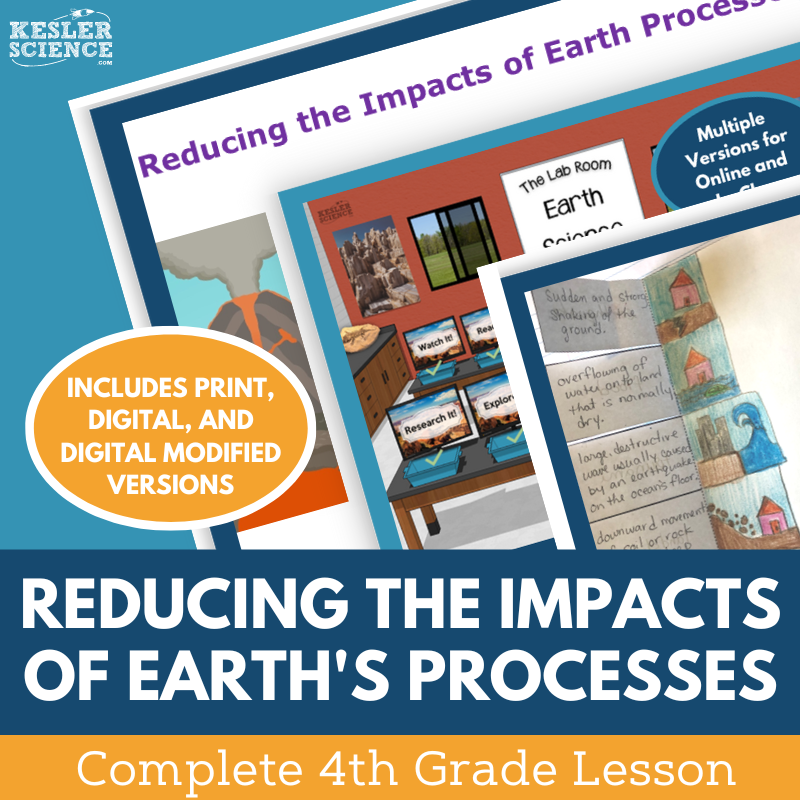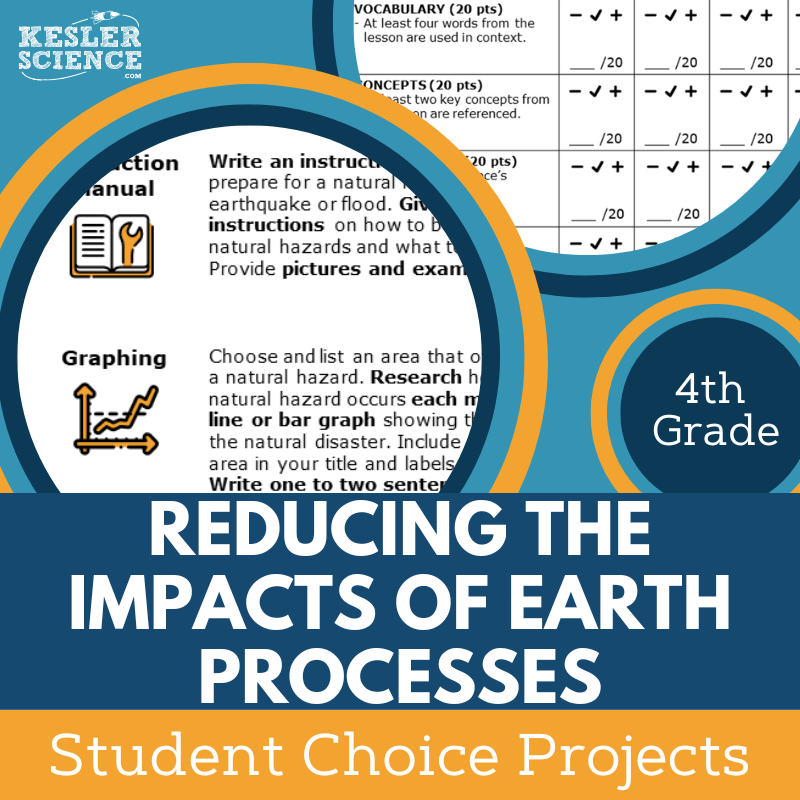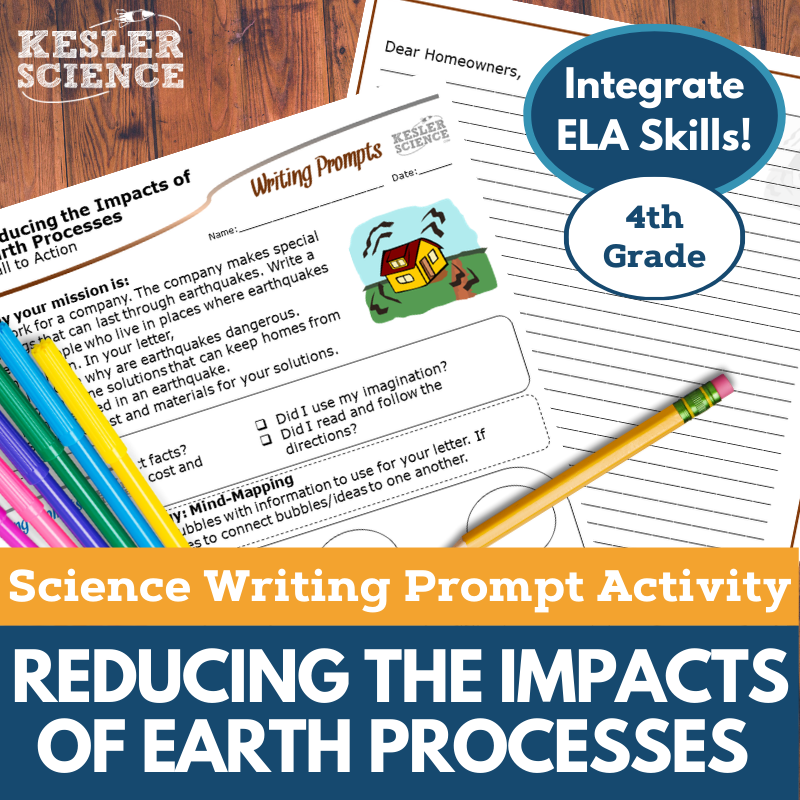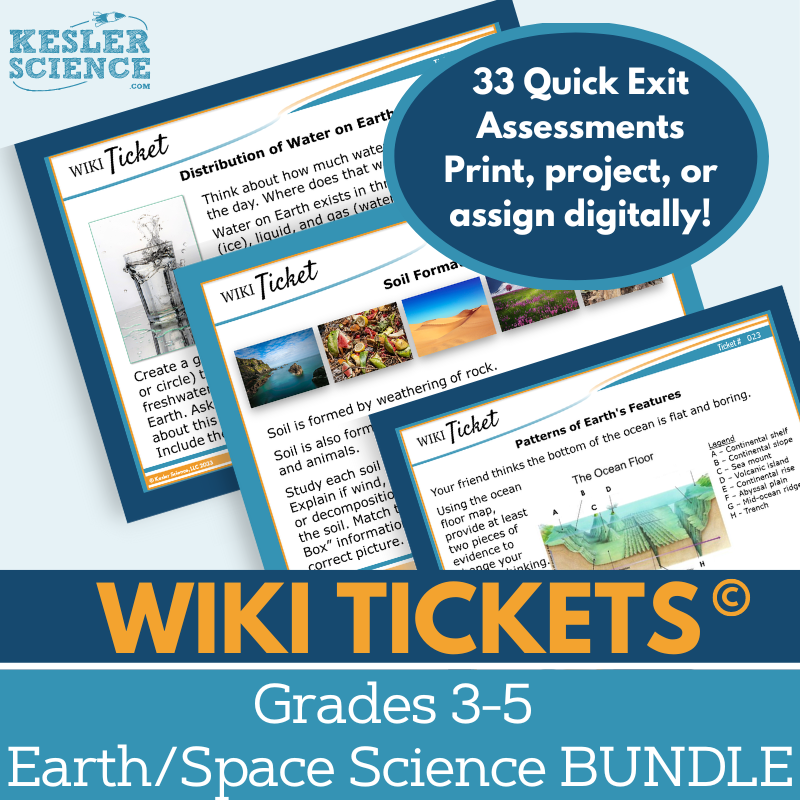Solutions to Natural Hazards Activities for 4th Grade Science
Students will explore ways to reduce the impacts of earth processes in this engaging, student-led 5E lesson designed for elementary earth science. The resources below will give students a comprehensive understanding of solutions to natural hazards. All of the following materials are also included in the Kesler Science Membership.
The Kesler Science 5E Lesson on reducing the impacts of earth processes is a comprehensive, student-led unit designed for elementary earth science. This multiday, low-prep lesson includes editable presentations, worksheets, student-choice projects, and assessments aligned with NGSS 4-ESS3-2. It incorporates multimodal and differentiated learning, with Spanish translations of key materials.
Following the 5E Model, the lesson begins with engaging discussions and activities to introduce natural hazards and their impact on humans. Students then explore the topic through a differentiated station lab with nine input and output stations, including hands-on experiments, reading passages, videos, research tasks, and interactive activities. A challenge station extends learning for early finishers. The explanation phase features editable PowerPoints, interactive notebooks, and note-taking templates. Students elaborate on their knowledge through choice projects, while evaluation includes STAAR 2.0-aligned assessments and review questions.
This resource offers maximum flexibility with digital and printable formats, making it adaptable for in-person and virtual learning environments.
The Kesler Science 5E Lesson on reducing the impacts of earth processes is a comprehensive, student-led unit designed for elementary earth science. This multiday, low-prep lesson includes editable presentations, worksheets, student-choice projects, and assessments aligned with NGSS 4-ESS3-2. It incorporates multimodal and differentiated learning, with Spanish translations of key materials.
Following the 5E Model, the lesson begins with engaging discussions and activities to introduce natural hazards and their impact on humans. Students then explore the topic through a differentiated station lab with nine input and output stations, including hands-on experiments, reading passages, videos, research tasks, and interactive activities. A challenge station extends learning for early finishers. The explanation phase features editable PowerPoints, interactive notebooks, and note-taking templates. Students elaborate on their knowledge through choice projects, while evaluation includes STAAR 2.0-aligned assessments and review questions.
This resource offers maximum flexibility with digital and printable formats, making it adaptable for in-person and virtual learning environments.
Engage your 4th-grade students with this student-led station lab on reducing the impacts of Earth processes. Designed for hands-on and virtual learning, this lesson allows students to generate and compare solutions to minimize the effects of natural Earth processes on humans.
With eight differentiated stations and a bonus challenge station, students explore new concepts through experiments, research, readings, and videos while demonstrating their learning through organization, illustration, writing, and assessments. The modular design supports independent or small-group work, with all necessary materials provided, plus digital options for PowerPoint and Google Slides.
This high-engagement, low-prep resource encourages active learning and critical thinking, making it a valuable addition to your earth science curriculum.
Engage your 4th-grade students with this student-led station lab on reducing the impacts of earth processes. Designed for hands-on and virtual learning, this lesson allows students to generate and compare solutions to minimize the effects of natural earth processes on humans.
With eight differentiated stations and a bonus challenge station, students explore new concepts through experiments, research, readings, and videos while demonstrating their learning through organization, illustration, writing, and assessments. The modular design supports independent or small-group work, with all necessary materials provided, plus digital options for PowerPoint and Google Slides.
This high-engagement, low-prep resource encourages active learning and critical thinking, making it a valuable addition to your earth science curriculum.
The Reducing the Impacts of Earth's Processes Student Choice Projects allow 4th-grade students to demonstrate their understanding through a project that matches their preferred output style. A project page outlines six student-led options plus a “design your own” project, all supported by an editable rubric for teacher, peer, or self-assessment.
These flexible, multimodal projects provide creative ways for students to engage with the content. Two versions of the project page offer differentiation, with modified options for students needing support and challenge options for advanced learners. Teachers can adjust the rubric to fit their grading needs.
The projects require standard classroom supplies like paper, markers, and scissors, with many options available for digital completion. Some crafting materials may be useful for building models.
The Reducing the Impacts of Earth's Processes Student Choice Projects allow 4th-grade students to demonstrate their understanding through a project that matches their preferred output style. A project page outlines six student-led options plus a “design your own” project, all supported by an editable rubric for teacher, peer, or self-assessment.
These flexible, multimodal projects provide creative ways for students to engage with the content. Two versions of the project page offer differentiation, with modified options for students needing support and challenge options for advanced learners. Teachers can adjust the rubric to fit their grading needs.
The projects require standard classroom supplies like paper, markers, and scissors, with many options available for digital completion. Some crafting materials may be useful for building models.
The Reducing the Impact of Earth Processes science writing activity engages 4th-grade students in testing their earth science knowledge through a call-to-action writing exercise. This fun, print-or-digital activity encourages students to extend their science reasoning and exploration while enhancing their writing skills. Designed for both in-person and virtual learning, it keeps students engaged inside or outside the classroom.
Aligned with NGSS 4-ESS3-2, this low-prep, student-centered resource supports elaboration or review. The activity includes teacher directions with an answer guide, project ideas, and rubrics. It also provides projection and print handouts, with full-sized and half-sheet versions, as well as a digital interactive format in PowerPoint and Google Slides. Ideal for cross-curricular use, pre-test assessments, student choice projects, extra credit, make-up work, or differentiation, this writing prompt is a valuable addition to any science curriculum.
The Reducing the Impact of Earth Processes science writing activity engages 4th-grade students in testing their earth science knowledge through a call-to-action writing exercise. This fun, print-or-digital activity encourages students to extend their science reasoning and exploration while enhancing their writing skills. Designed for both in-person and virtual learning, it keeps students engaged inside or outside the classroom.
Aligned with NGSS 4-ESS3-2, this low-prep, student-centered resource supports elaboration or review. The activity includes teacher directions with an answer guide, project ideas, and rubrics. It also provides projection and print handouts, with full-sized and half-sheet versions, as well as a digital interactive format in PowerPoint and Google Slides. Ideal for cross-curricular use, pre-test assessments, student choice projects, extra credit, make-up work, or differentiation, this writing prompt is a valuable addition to any science curriculum.
The WIKI Tickets© Earth/Space Science Set provides 33 engaging formative assessments for 3rd–5th grade science. Each topic includes five format options: a full-screen projection version, three printable handout sizes, and an interactive digital version compatible with PowerPoint and Google Slides.
Aligned with NGSS and TEKS standards, these assessments cover key earth, space, and weather science topics such as the water cycle, reducing the impacts of Earth processes, landscape changes over time, natural resources, and patterns of Earth's features. Some topics have multiple tickets, ensuring comprehensive coverage of all standards. A bonus table of contents file is included for easy alignment reference.
WIKI Tickets© can be used in both in-person and virtual learning environments. Students can respond on paper, interact digitally, or complete assignments remotely. These assessments work as exit tickets, bellringers, or quick checks, helping you gauge student understanding in a flexible and engaging way.
The WIKI Tickets© Earth/Space Science Set provides 33 engaging formative assessments for 3rd–5th grade science. Each topic includes five format options: a full-screen projection version, three printable handout sizes, and an interactive digital version compatible with PowerPoint and Google Slides.
Aligned with NGSS and TEKS standards, these assessments cover key earth, space, and weather science topics such as the water cycle, reducing the impacts of Earth processes, landscape changes over time, natural resources, and patterns of Earth's features. Some topics have multiple tickets, ensuring comprehensive coverage of all standards. A bonus table of contents file is included for easy alignment reference.
WIKI Tickets© can be used in both in-person and virtual learning environments. Students can respond on paper, interact digitally, or complete assignments remotely. These assessments work as exit tickets, bellringers, or quick checks, helping you gauge student understanding in a flexible and engaging way.
Year-Round Resources
These year-round activities will increase your students' understanding of many middle school science topics. All of these activities are also included in the Kesler Science Membership.
Visual Data & Graphing
You're not alone if your students struggle with understanding graphs, charts, and tables. It's a skill that takes an enormous amount of practice. This resource will help students build a strong foundation in analyzing data and creating their own data visualizations.
Bell Ringers and Warm-Ups
These middle school science bell ringers are an excellent way to engage your students as soon as they walk into your classroom. This comprehensive FULL YEAR resource includes everything you need to start off each science class with an interesting warm-up activity.
Review Board Games
Each game board has been carefully designed to keep students engaged. There are 10 different action spaces on each board and dozens of question cards. All of the actions are related to science concepts and keep the students motivated throughout the game.
Each game is ready to play. Simply print out the board and the cards and let the students enjoy reviewing nine different units.
Essential Questions and Standards
Below are the essential questions and standards associated with the lessons and activities included in the solutions to natural hazards unit. This topic is only one of more than 100 middle school science topics included in the Kesler Science Membership.
-
What are the natural hazards on Earth that impact humans?
-
What are some solutions to reduce the impact of natural hazards on humans?
-
NGSS - 4-ESS3-2 Solutions to Natural Hazards
Kesler Science Membership
Imagine never having to search for another middle school science lesson again. The membership gives you access to ALL of the Kesler Science products in one place (Yes, including everything above).
Say goodbye to long hours of lesson prep.











